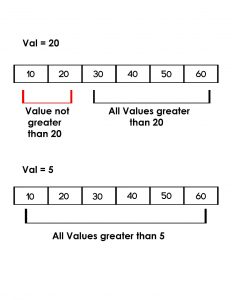
例子:
Input : list = [10, 20, 30, 40, 50]
given value = 20
Output : No
Input : list = [10, 20, 30, 40, 50]
given value = 5
Output : Yes方法1:遍历列表
通过遍历列表, 我们可以比较每个元素并检查给定列表中的所有元素是否大于给定值。
# python program to check if all
# values in the list are greater
# than val using traversal
def check(list1, val):
# traverse in the list
for x in list1:
# compare with all the values
# with val
if val> = x:
return False
return True
# driver code
list1 = [ 10 , 20 , 30 , 40 , 50 , 60 ]
val = 5
if (check(list1, val)):
print "Yes"
else :
print "No"
val = 20
if (check(list1, val)):
print "Yes"
else :
print "No"输出如下:
Yes
No方法2:使用all()函数:
使用all()函数我们可以检查所有值是否都大于一行中的任何给定值。如果all()函数中的给定条件对于所有值都为true, 则返回true, 否则返回false。
# python program to check if all
# values in the list are greater
# than val using all() function
def check(list1, val):
return ( all (x> val for x in list1))
# driver code
list1 = [ 10 , 20 , 30 , 40 , 50 , 60 ]
val = 5
if (check(list1, val)):
print "Yes"
else :
print "No"
val = 20
if (check(list1, val)):
print "Yes"
else :
print "No"输出如下:
Yes
No首先, 你的面试准备可通过以下方式增强你的数据结构概念:Python DS课程。

![从字法上最小长度N的排列,使得对于正好为K个索引,a[i] a[i]+1](https://www.lsbin.com/wp-content/themes/begin%20lts/img/loading.png)